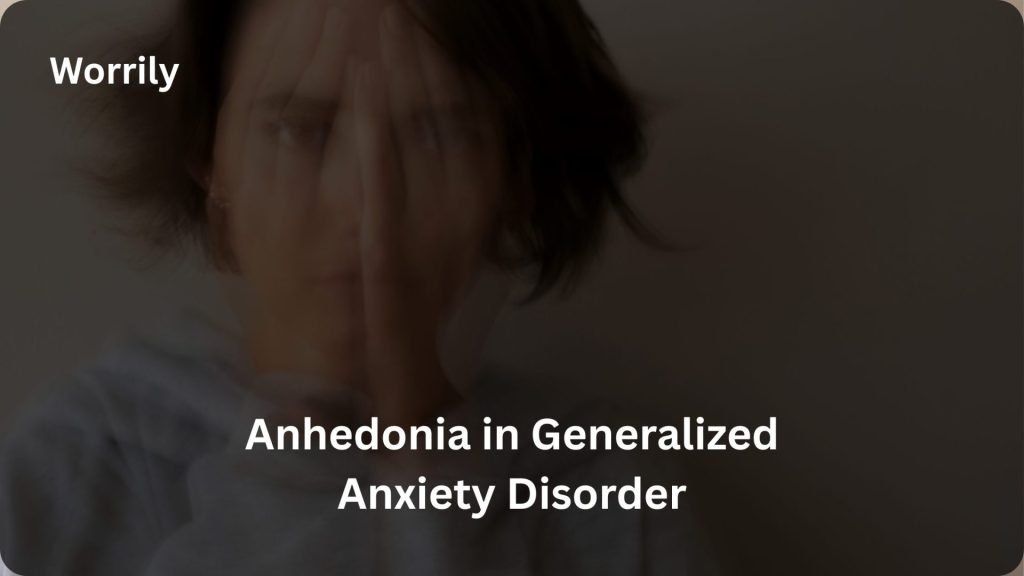Anhedonia, a condition characterized by the inability to experience pleasure or interest in activities that would usually be enjoyable, is commonly associated with depression. However, it can also occur in individuals with other mental health disorders, such as generalized anxiety disorder (GAD).
If you or someone you know is dealing with GAD, understanding the connection between this anxiety disorder and anhedonia is crucial for proper treatment and management.
In this comprehensive blog post, we will dive deep into how common anhedonia is in generalized anxiety disorder, its relationship with anxiety, and the symptoms and challenges people with GAD experience. We will also provide insights into who is most affected by GAD and whether those with anxiety can break free from constant worry.
Additionally, we’ll explore the importance of mental conditioning in managing anxiety and other mental health challenges.
Can You Get Anhedonia from Anxiety?

Credit : Osmosis
While anhedonia is more closely associated with depression, it can also occur in individuals with generalized anxiety disorder. People with GAD experience excessive worry, tension, and fear, often about everyday situations.
These constant problems can interfere with their ability to enjoy normal activities or hobbies that once brought them joy, leading to anhedonia.
Anhedonia in GAD is typically linked to the emotional and mental exhaustion that anxiety brings. Persistent stress can wear down the brain’s reward system, leading to a capacity for experiencing pleasure.
This can make the experience of anhedonia feel much like depression, as individuals may feel disconnected from their surroundings and uninterested in things they once loved.
This is similar to how an athlete might experience burnout when the pressure to perform compromises their ability to find enjoyment in their sport, despite previously having a strong passion for it. I
So yes, it is possible to experience anhedonia as a symptom of anxiety, especially when the anxiety becomes chronic and overwhelming.
How Common Is Anhedonia in Generalized Anxiety Disorder?
Anhedonia in generalized anxiety disorder is not uncommon, but it is often underreported or misunderstood.
Anxiety disorders, including GAD, can cause emotional numbness, a feeling of being “stuck,” or a lack of motivation, all of which are closely related to anhedonia.
A study published by the National Institutes of Health (NIH) revealed that people with anxiety disorders, including GAD, are more likely to experience symptoms of anhedonia than the general population.
While the exact statistics on how common anhedonia is in GAD are limited, experts believe that it affects a significant portion of those dealing with chronic anxiety.
The prevalence of anhedonia among individuals with GAD can vary based on the severity of the anxiety disorder and the presence of comorbid conditions like depression.
The overlap between anxiety and depressive symptoms can make it difficult to distinguish between the two, with many individuals experiencing both.
If we look at it from a sports psychology perspective, just as athletes experience mental fatigue that affects their performance, individuals with GAD may feel mentally drained to the point where even the activities they once enjoyed become unappealing.
Mental conditioning can play a significant role in managing these symptoms, just like it helps athletes stay focused and motivated despite external pressures.
How Common Is Generalized Anxiety Disorder?
Generalized anxiety disorder (GAD) is one of the most prevalent anxiety disorders worldwide. According to the Anxiety and Depression Association of America (ADAA), approximately 6.8 million adults in the United States suffer from GAD, which accounts for about 3.1% of the U.S. population.
Globally, the prevalence of GAD varies, but studies estimate that between 2.5% and 7% of the population will experience GAD at some point in their lives. It is important to note that GAD is more common in women than in men, and it often develops in childhood or early adulthood.
As with consistency in sports, where athletes are expected to maintain regular training to see improvement, individuals with GAD often struggle with maintaining a balanced emotional state.
This struggle with consistency can exacerbate their anxiety and make it more difficult to manage their emotional well-being.

What Percent of People Have Anhedonia?
Anhedonia is commonly linked to mood disorders like depression, but it can also appear in people with anxiety disorders, such as GAD.
According to research from the National Institute of Mental Health (NIMH), approximately 25% to 40% of individuals with major depressive disorder experience anhedonia.
When it comes to GAD, estimates are less precise, but the occurrence of anhedonia among those with GAD can range from 10% to 30%, depending on the severity and duration of the disorder.
This underlines the importance of managing anxiety early on to prevent the development of other symptoms, including anhedonia.
Can People with GAD Stop Worrying?
One of the most challenging aspects of generalized anxiety disorder is the constant, uncontrollable worrying. People with GAD often feel overwhelmed by fears about the future, daily tasks, and their overall well-being, even when there is no immediate threat. But can they stop worrying?
While it may be difficult, yes, people with GAD can learn to manage and reduce excessive worry through a combination of therapy, lifestyle changes, and, in some cases, medication.
Cognitive behavioral therapy (CBT) has been shown to be particularly effective in helping individuals identify and challenge negative thought patterns that fuel their anxiety.
Mindfulness practices and relaxation techniques can also help reduce the physiological effects of anxiety and promote a sense of calm.
Much like athletes who build mental conditioning to deal with performance pressure, individuals with GAD can benefit from training their minds to shift focus away from excessive worry.
With practice and dedication, it is possible to regain a sense of control over anxious thoughts and reduce their impact on daily life.
However, complete cessation of worry may not be entirely realistic for all individuals with GAD, as the condition often requires long-term management. The goal is to help individuals cope better with anxiety and reduce the impact it has on their daily lives.

Who Suffers the Most from Generalized Anxiety Disorder?
Generalized anxiety disorder affects people of all ages, but certain demographics may be more vulnerable. Women are more likely to develop GAD than men, with a ratio of about 2:1. GAD also often emerges during childhood or early adulthood, making young adults a particularly susceptible group.
Additionally, individuals who have experienced significant trauma, stress, or abuse may be more prone to developing anxiety disorders, including GAD.
There is also a notable association between other mental health conditions, such as depression and substance abuse, and GAD. People with a family history of anxiety or other mental health disorders are at higher risk as well.
While anyone can experience GAD, those with a combination of genetic, environmental, and psychological risk factors are the most likely to develop it.
Conclusion
Anhedonia is a common and often distressing symptom of generalized anxiety disorder, though it is frequently overshadowed by the more obvious signs of anxiety, such as excessive worry and fear.
The presence of anhedonia in GAD highlights the complex nature of the disorder, which can overlap with symptoms of depression, making accurate diagnosis and treatment essential.
With proper care and attention, individuals with GAD can manage their symptoms, reduce their worries, and find ways to rediscover pleasure in life, even if anhedonia has taken hold.
If you or someone you know is struggling with generalized anxiety disorder and experiencing anhedonia, it’s crucial to seek professional help.
A tailored treatment plan, which may include therapy, medication, and lifestyle changes, can greatly improve quality of life and help individuals regain a sense of joy and fulfillment.
